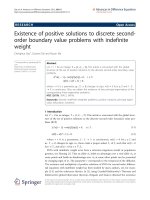báo cáo hóa học:" Existence of positive solutions for fourth-order semipositone multi-point boundary value problems with a sign-changing nonlinear term" docx
Bạn đang xem bản rút gọn của tài liệu. Xem và tải ngay bản đầy đủ của tài liệu tại đây (251.8 KB, 25 trang )
This Provisional PDF corresponds to the article as it appeared upon acceptance. Fully formatted
PDF and full text (HTML) versions will be made available soon.
Existence of positive solutions for fourth-order semipositone multi-point
boundary value problems with a sign-changing nonlinear term
Boundary Value Problems 2012, 2012:12 doi:10.1186/1687-2770-2012-12
Yan Sun ()
ISSN 1687-2770
Article type Research
Submission date 23 July 2011
Acceptance date 9 February 2012
Publication date 9 February 2012
Article URL />This peer-reviewed article was published immediately upon acceptance. It can be downloaded,
printed and distributed freely for any purposes (see copyright notice below).
For information about publishing your research in Boundary Value Problems go to
/>For information about other SpringerOpen publications go to
Boundary Value Problems
© 2012 Sun ; licensee Springer.
This is an open access article distributed under the terms of the Creative Commons Attribution License ( />which permits unrestricted use, distribution, and reproduction in any medium, provided the original work is properly cited.
Existence of positive solutions for fourth-order
semipositone multi-p oint boundary value problems
with a sign-changing nonlinear term
Yan Sun
Department of Mathematics, Shanghai Normal University,
Shanghai 200234, People’s Republic of China
Email addresses: ;
Abstract
In this article, some new sufficient conditions are obtained by making use of fixed
point index theory in cone and constructing some available integral operators to-
gether with approximating technique. They guarantee the existence of at least one
positive solution for nonlinear fourth-order semipositone multi-point boundary value
problems. The interesting point is that the nonlinear term f not only involve with
the first-order and the second-order derivatives explicitly, but also may be allowed
to change sign and may be singular at t = 0 and/or t = 1. Moreover, some stronger
conditions that common nonlinear term f ≥ 0 will be modified. Finally, two exam-
ples are given to demonstrate the validity of our main results.
1
2
Keywords: semip ositone; positive solutions; multi-point boundary value problems.
2000 Mathematics Subject Classification: 34B10; 34B18; 47N20.
1 Introduction
In this article, we consider the existence of positive solutions to the following nonlinear
fourth-order semipositone multi-point boundary value problems with derivatives
y
(4)
(t) + λf (t, y(t), y
(t), y
(t)) = 0, 0 < t < 1,
y(0) = y
(0) = 0, y
(1) =
m−2
i=1
α
i
y
(ξ
i
), y
(0) =
m−2
i=1
β
i
y
(ξ
i
),
(1.1)
where f ∈ C((0, 1)×R×R×R, R) satisfies f (t, y
1
, y
2
, y
3
) ≥ −p(t), p ∈ L
1
((0, 1), (0, +∞)).
λ > 0, ξ
i
∈ (0, 1) with 0 < ξ
1
< ξ
2
< ··· < ξ
m−2
< 1, α
i
, β
i
∈ [0, +∞), i = 1, 2, . . . , m−2,
are given constants satisfying 0 <
m−2
i=1
α
i
< 1, 0 <
m−2
i=1
β
i
< 1. Here, by a positive solution
of the problem (1.1) we mean a function y
∗
(t) which is positive on (0, 1) and satisfies the
problem (1.1).
The existence of positive solutions for multi-point boundary value problems has been
widely studied in recent years. For details, see [1–15] and references therein. We note
that the existence of n solutions and/or positive solutions to the following semipositone
elastic beam equation boundary value problem
u
(4)
(t) = f(t, u(t), u
(t)), t ∈ (0, 1),
u(0) = u(1) = u
(0) = u
(1) = 0,
was obtained by Yao [13] in a Banach space setting. Gupta [3] proved the existence of
3
positive solutions for more general multi-point boundary value problems
x
(t) = g(t, x(t), x
(t)) + e(t), a. e. t ∈ (0, 1)
x(0) =
m−2
i=1
h
i
x(τ
i
), x
(1) =
m−2
i=1
k
i
x
(ξ
i
).
For further background information of multi-point boundary value problems we refer
the reader to [11, 12, 16]. However, in previous work, the positivity which imposed on
nonlinear term plays an important role for boundary value problems. Naturally, one is
interested in establishing the existence of positive solutions for multi-point boundary value
problems under the relaxed conditions.
Inspired and motivated greatly by the above mentioned works, the present work may
be viewed as a direct attempt to extend the results of [3,13] to a broader class of nonlinear
boundary value problems in a general Banach spaces. When the nonlinearity is negative,
such kinds of the problems are called semipositone problems, which occur in chemical
rector theory, combustion and management of natural resources, see [11, 13–16]. To our
best knowledge, few results were obtained for the problem (1.1).
The purpose of the article is to establish some new criteria for the existence of positive
solutions to the problem (1.1). The nonlinear term f may take negative values and
the nonlinearity may be sign-changing. Firstly, we employ a exchange technique and
construct an integral operator for the corresponding second-order multi-point boundary
value problem. Then we establish a special cone associated with concavity of functions.
Finally, the existence of positive solutions for the problem (1.1) is obtained by applying
fixed-point index theory. The common restriction on f ≥ 0 is modified.
The plan of the article is as follows. Section 2 contains a number of lemmas useful
4
to the derivation of the main results. The proof of the main results will be stated in
Section 3. A class of examples are given to show that our main result is applicable to
many problems in Section 4.
2 Preliminaries and lemmas
In this section, we shall state some necessary definitions and preliminaries.
Definition 2.1. Let E be a real Banach space. A nonempty closed convex set K ⊂ E is
called a cone if it satisfies the following two conditions:
(1) x ∈ K, λ > 0 implies λx ∈ K;
(2) x ∈ K, −x ∈ K implies x = 0.
Definition 2.2. An operator T is cal led completely continuous if it is continuous and
maps bounded sets into precompact sets.
For convenience, we list the following assumptions:
(H
1
) For i ∈ {1, 2, ··· , m − 2}, ξ
i
∈ (0, 1), 0 < ξ
1
< ξ
2
< ··· < ξ
m−2
< 1 and
α
i
, β
i
∈ [0, +∞) satisfying 0 <
m−2
i=1
α
i
< 1, 0 <
m−2
i=1
β
i
< 1 and 0 <
m−2
i=1
α
i
ξ
i
< 1.
(H
2
) f ∈ C((0, 1) × R × R × R, R) and there exist functions p, q ∈ L
1
((0, 1), (0, +∞)),
g ∈ C(R × R × R, (0, +∞)) such that
−p(t) ≤ f(t, x
1
, x
2
, x
3
) ≤ q(t)g(x
1
, x
2
, x
3
) for (t, x
1
, x
2
, x
3
) ∈ (0, 1) × R × R × R.
(H
3
) lim
(|x
1
|+|x
2
|+|x
3
|)→+∞
f(t, x
1
, x
2
, x
3
)
|x
1
|+|x
2
|+|x
3
|
= +∞ for t uniformly on [0, 1].
Remark 2.1. From (H
2
) we know that for given points t
1
, t
2
, . . . , t
m
on [0, 1], the
functions p, q = (0, 1) \ {t
i
, i = 1, 2, . . . , m} −→ (0, +∞) are continuous and integrable,
5
that is 0 <
1
0
(p(t) + q(t))dt < +∞. The condition (H
2
) also implies that f may have
finitely singularities at t
1
, t
2
, . . . , t
m
on [0, 1].
Lemma 2.1. Suppose that (H
1
) and (H
2
) hold. Then the problem (1.1) has a positive
solution if and only if the following nonlinear second-order integro-differential equation
x
(t) + λf
t,
t
0
(t − u)x(u)du,
t
0
x(u)du, x(t)
= 0, 0 < t < 1,
x
(0) =
m−2
i=1
β
i
x
(ξ
i
), x(1) =
m−2
i=1
α
i
x(ξ
i
)
(2.1)
has a positive solution.
Proof. Let y(t) be a positive solution of the problem (1.1) and let x(t) = y
(t). Then it
follows from the problem (1.1) and combining with exchanging the integral sequence we
know that
y(t) =
t
0
(t − u)x(u)du, y
(t) =
t
0
x(u)du.
Thus x(t) = y
(t) is a positive solution of the second-order integro-differential equation
multi-point boundary value problem (2.1).
Conversely, let x(t) be a positive solution of the problem (2.1), then y(t) =
t
0
(t −
u)x(u)du is a positive solution of the problem (1.1). In fact, y
(t) =
t
0
x(u)du, y
(t) =
x(t), which implies that y(0) = 0, y
(0) = 0. The proof is complete.
Now, let X = C[0, 1]. Then X is a real Banach space with norm x = max
t∈[0,1]
|x(t)| for
x ∈ C[0, 1]. Let
C
+
[0, 1] = {x ∈ C[0, 1] : x(t) ≥ 0, t ∈ [0, 1]}.
Lemma 2.2. Suppose that (H
1
) holds. In addition, assume that u(t) ∈ L
1
(0, 1) and
6
u(t) ≥ 0. Then the following problem
x
(t) + u(t) = 0, 0 < t < 1,
x
(0) =
m−2
i=1
β
i
x
(ξ
i
), x(1) =
m−2
i=1
α
i
x(ξ
i
)
(2.2)
has a unique positive solution
x(t) = −
t
0
(t − s)u(s)ds +
m−2
i=1
β
i
ξ
i
0
u(s)ds
m−2
i=1
β
i
− 1
t +
1
1 −
m−2
i=1
α
i
1
0
(1 − s)u(s)ds
−
1
1 −
m−2
i=1
α
i
m−2
i=1
α
i
ξ
i
0
(ξ
i
− s)u(s)ds +
m−2
i=1
β
i
ξ
i
0
u(s)ds
m−2
i=1
β
i
− 1
1 −
m−2
i=1
α
i
ξ
i
(2.3)
satisfies x(t) ≥ 0, t ∈ [0, 1] and
min
t∈[0,1]
x(t) ≥ wx, (2.4)
where
ω =
m−2
i=1
α
i
(1 − ξ
i
)
1 −
m−2
i=1
α
i
ξ
i
. (2.5)
Proof. From (2.2), we have x
(t) = −u(t), 0 < t < 1. For t ∈ [0, 1], integrating from
0 to t we get
x
(t) = x
(0) −
t
0
u(s)ds. (2.6)
Thus
x
(0) =
m−2
i=1
β
i
x
(ξ
i
) =
m−2
i=1
β
i
m−2
i=1
β
i
− 1
ξ
i
0
u(s)ds. (2.7)
For t ∈ [0, 1], integrating (2.6) from t to 1 yields
x(1) − x(t) =
m−2
i=1
β
i
(1 − t)
m−2
i=1
β
i
− 1
ξ
i
0
u(s)ds −
t
0
(s − t)u(s)ds −
1
0
(1 − s)u(s)ds, (2.8)
7
which means that
−x(t) = −
m−2
i=1
α
i
x(ξ
i
) +
m−2
i=1
β
i
ξ
i
0
u(s)ds
m−2
i=1
β
i
− 1
−
m−2
i=1
β
i
ξ
i
0
u(s)ds
m−2
i=1
β
i
− 1
t
+
t
0
(t − s)u(s)ds −
1
0
(1 − s)u(s)ds.
(2.9)
From (2.9), we have
x(ξ
i
) =
1
1 −
m−2
i=1
α
i
1
0
(1−s)u(s)ds−
m−2
i=1
β
i
(1 − ξ
i
)
ξ
i
0
u(s)ds
m−2
i=1
β
i
− 1
−
ξ
i
0
(ξ
i
−s)u(s)ds
. (2.10)
It follows from (2.9) and (2.10) that
x(t) = −
t
0
(t − s)u(s)ds +
m−2
i=1
β
i
ξ
i
0
u(s)ds
m−2
i=1
β
i
− 1
t +
1
0
(1 − s)u(s)ds
+
1
1 −
m−2
i=1
α
i
m−2
i=1
α
i
1
0
(1 − s)u(s)ds
−
m−2
i=1
α
i
ξ
i
0
(ξ
i
− s)u(s)ds −
m−2
i=1
β
i
ξ
i
0
u(s)ds
m−2
i=1
β
i
− 1
·
1 −
m−2
i=1
α
i
ξ
i
= −
t
0
(t − s)u(s)ds +
m−2
i=1
β
i
ξ
i
0
u(s)ds
m−2
i=1
β
i
− 1
t +
1
1 −
m−2
i=1
α
i
1
0
(1 − s)u(s)ds
−
1
1 −
m−2
i=1
α
i
m−2
i=1
α
i
ξ
i
0
(ξ
i
− s)u(s)ds +
m−2
i=1
β
i
ξ
i
0
u(s)ds
m−2
i=1
β
i
− 1
1 −
m−2
i=1
α
i
ξ
i
.
(2.11)
8
Combining (2.11) with (H
1
) we know that
x(0) =
1
1 −
m−2
i=1
α
i
1
0
(1 − s)u(s)ds −
m−2
i=1
α
i
ξ
i
0
(ξ
i
− s)u(s)ds
−
m−2
i=1
β
i
ξ
i
0
u(s)ds
m−2
i=1
β
i
− 1
1 −
m−2
i=1
α
i
ξ
i
≥
1
1 −
m−2
i=1
α
i
m−2
i=1
α
i
1
0
(1 − s)u(s)ds −
m−2
i=1
α
i
ξ
i
0
(ξ
i
− s)u(s)ds
−
m−2
i=1
β
i
ξ
i
0
u(s)ds
m−2
i=1
β
i
− 1
1 −
m−2
i=1
α
i
ξ
i
≥
m−2
i=1
α
i
1 −
m−2
i=1
α
i
1
ξ
i
(1 − s)u(s)ds +
m−2
i=1
β
i
ξ
i
0
u(s)ds
1 −
m−2
i=1
α
i
ξ
i
1 −
m−2
i=1
β
i
1 −
m−2
i=1
α
i
≥ 0.
(2.12)
From the fact that x
(t) = −u(t) ≤ 0, we know that the graph of x(t) is concave on [0, 1].
Thus
If x(1) ≥ 0, we know that x(t) ≥ 0 for all t ∈ [0, 1].
If x(1) < 0, from the concavity of x once again we know that
x(ξ
i
)
ξ
i
≥
x(1)
1
for i ∈ {1, 2, . . . , m − 2}. This implies
x(1) =
m−2
i=1
α
i
x(ξ
i
) ≥
m−2
i=1
α
i
ξ
i
x(1),
which contracts with the fact 0 <
m−2
i=1
α
i
ξ
i
< 1. Thus we know that (2.4) holds.
Again from x
(t) = −u(t) ≤ 0, we see that x
(t) is non-increasing on (0, 1). Combining
the condition 0 <
m−2
i=1
β
i
< 1 we have x
(0) ≤ 0 and x
(t) = x
(0) −
t
0
u(s)ds ≤ 0 for
9
t ∈ (0, 1). Hence x(t) is non-increasing on (0, 1). By making use of the concavity of x(t) on
(0, 1) we get x = x(0) and min
t∈[0,1]
x(t) = x(1). Therefore, for all i = 1, 2, ··· , m −2,
we obtain
x = x(0) ≤ x(1) +
x(ξ
i
) − x(1)
1 − ξ
i
(1 − 0) = x(1) +
x(ξ
i
)
1 − ξ
i
−
x(1)
1 − ξ
i
=
x(ξ
i
) − x(1)ξ
i
1 − ξ
i
=
1 −
m−2
i=1
α
i
ξ
i
m−2
i=1
α
i
(1 − ξ
i
)
x(1),
which implies that
min
t∈[0,1]
x(t) ≥
m−2
i=1
α
i
(1 − ξ
i
)
1 −
m−2
i=1
α
i
ξ
i
x = ωx
where ω is given by (2.5). This completes the proof.
Lemma 2.3. Suppose that (H
1
) holds. In addition, assume that p ∈ L
1
((0, 1), (0, +∞)).
Then the following boundary value problem
x
(t) + λp(t) = 0, 0 < t < 1,
x
(0) =
m−2
i=1
β
i
x
(ξ
i
), x(1) =
m−2
i=1
α
i
x(ξ
i
)
(2.13)
has a unique positive solution z satisfying z(t) ≥ 0, t ∈ [0, 1], min
t∈[0, 1]
z(t) ≥ ωz and
z(t) ≤ λGω
1
0
p(s)ds, (2.14)
where
G =
1
1 −
m−2
i=1
α
i
+
m−2
i=1
β
i
1 −
m−2
i=1
α
i
ξ
i
1 −
m−2
i=1
α
i
1 −
m−2
i=1
β
i
ω
−1
,
ω is given by (2.5).
10
Proof. From Lemma 2.2. we have z(t) ≥ 0 and min
t∈[0,1]
z(t) ≥ ωz, t ∈ [0, 1]. By making
use of (2.3) we get
z(t) ≤
λ
1 −
m−2
i=1
α
i
1
0
(1 − s)p(s)ds −
m−2
i=1
α
i
ξ
i
0
(ξ
i
− s)p(s)ds
+
m−2
i=1
β
i
ξ
i
0
p(s)ds
1 −
m−2
i=1
β
i
·
1 −
m−2
i=1
α
i
ξ
i
≤
λ
1 −
m−2
i=1
α
i
1
0
p(s)ds +
m−2
i=1
β
i
1
0
p(s)ds
1 −
m−2
i=1
β
i
1 −
m−2
i=1
α
i
ξ
i
= λ
1
0
p(s)ds
1
1 −
m−2
i=1
α
i
+
m−2
i=1
β
i
1 −
m−2
i=1
α
i
ξ
i
1 −
m−2
i=1
α
i
1 −
m−2
i=1
β
i
= λGω
1
0
p(s)ds.
The proof is complete.
Let
[v(t)]
∗
=
v(t), v(t) ≥ 0,
0, v(t) < 0,
0 < t < 1.
and
F (t, [x(t) − z(t)]
∗
) = f
t,
t
0
(t − u)[x(u) −z(u)]
∗
du,
t
0
[x(u) − z(u)]
∗
du,
[x(t) − z(t)]
∗
+ p(t).
Lemma 2.4. Suppose that (H
1
) and (H
2
) hold. Then the following nonlinear second-
11
order integro-differential equation boundary value problem
x
(t) + λ
f
t,
t
0
(t − u)[x(u) − z(u)]
∗
du,
t
0
[x(u) − z(u)]
∗
du,
[x(t) − z(t)]
∗
+ p(t)
= 0, 0 < t < 1,
x
(0) =
m−2
i=1
β
i
x
(ξ
i
), x(1) =
m−2
i=1
α
i
x(ξ
i
)
(2.15)
has a positive solution x(t) with x(t) ≥ z(t) for t ∈ [0, 1] if and only if y(t) = x(t) − z(t)
is a nonnegative solution (positive on (0, 1)) of the problem (2.1).
Proof. Assume that y(t) = x(t) −z(t) is a nonnegative solution (positive on (0,1)) of the
problem (2.1). Then we know that x(t) ≥ z(t) and
y
(t) + λf
t,
t
0
(t − u)y(u)du,
t
0
y(u)du, y(t)
= 0.
Noticing that z is a positive solution of the problem (2.13). Thus we get
−x
(t) = λ
f
t,
t
0
(t − u)[x(u) − z(u)]
∗
du,
t
0
[x(u) − z(u)]
∗
du, [x(t) − z(t)]
∗
+ p(t)
Therefore x(t) is a positive solution of the problem (2.15) with x(t) ≥ z(t) for t ∈ [0, 1].
Conversely, we assume that x(t) and z(t) are positive solutions of the problem (2.15)
and the problem (2.13), respectively, and it implies that the boundary conditions of the
problem (2.13) are also satisfied. Thus y(t) = x(t)−z(t) is a nonnegative solution (positive
on (0, 1)) of the problem (2.1). The proof is complete.
Remark 2.2. Combining Lemma 2.4. with Lemma 2.1. we know that if the problem
(2.15) has a positive solution, then the fourth-order multi-point boundary value problem
(1.1) has a positive solution. So, we need only to study the problem (2.15).
Remark 2.3. For any fixed x ∈ C
+
[0, 1], let L = max
t∈[0,1]
x(t). Noticing that [x(u)−z(u)]
∗
≤
12
x(u) ≤ L and
s
0
(s − u)[x(u) − z(u)]
∗
du
≤
1
0
Ldu = L, by virtue of (H
2
), we obtain
1
0
F (s, [x(s) − z(s)]
∗
)ds ≤
1
0
q(s)g
s
0
(s − u)[x(u) − z(u)]
∗
du,
s
0
[x(u) − z(u)]
∗
du, [x(s) − z(s)]
∗
+ p(s)
ds
≤
1
0
(p(s) + M q(s))ds
≤ M
1
0
(p(s) + q(s))ds < +∞,
(2.16)
where
M = max
(|u
1
|,|u
2
|,|u
3
|)∈[0,L]×[0,L]×[0,L]
g(|u
1
|, |u
2
|, |u
3
|) + 1. (2.17)
We introduce an integral mapping T : C
+
[0, 1] −→ C
+
[0, 1] defined by
(T x)(t) = −λ
t
0
(t − s)F (s, [x(s) − z(s)]
∗
)ds
−
t
m−2
i=1
β
i
ξ
i
0
F (s, [x(s) − z(s)]
∗
)ds
1 −
m−2
i=1
β
i
+
λ
1 −
m−2
i=1
α
i
1
0
(1 − s)F (s, [x(s) − z(s)]
∗
)ds
−
m−2
i=1
α
i
ξ
i
0
(ξ
i
− s)F (s, [x(s) − z(s)]
∗
)ds
+
m−2
i=1
β
i
ξ
i
0
F (s, [x(s) − z(s)]
∗
)ds
1 −
m−2
i=1
β
i
1 −
m−2
i=1
α
i
ξ
i
.
(2.18)
Denote
K = {y ∈ C
+
[0, 1] : min
0≤t≤1
y(t) ≥ ωy },
13
where ω is given by the problem (2.5). It is obvious that K is a positive cone of C[0, 1].
Lemma 2.5. Suppose that (H
1
) − (H
3
) hold. Then T : K −→ K is a completely
continuous operator.
Proof. It follows from Lemma 2.2. we see T (K) ⊂ K. Combining (H
1
) with (2.18) we
know that T (K) is equicontinuous and uniformly bounded. In fact, let D ⊂ C
+
[0, 1] be
a bounded set. Then there exists M
0
> 0 such that x ≤ M
0
for all x ∈ D. By virtue of
(H
2
) we obtain
|(T x)(t)| =
− λ
t
0
(t − s)F (s, [x(s) − z(s)]
∗
)ds −
λ
m−2
i=1
β
i
ξ
i
0
F (s, [x(s) − z(s)]
∗
)ds
1 −
m−2
i=1
β
i
t
+
λ
1 −
m−2
i=1
α
i
1
0
(1 − s)F (s, [x(s) − z(s)]
∗
)ds −
m−2
i=1
α
i
ξ
i
0
(ξ
i
− s)F (s, [x(s) − z(s)]
∗
)ds
−
m−2
i=1
β
i
ξ
i
0
F (s, [x(s) − z(s)]
∗
)ds
m−2
i=1
β
i
− 1
1 −
m−2
i=1
α
i
ξ
i
≤
λ
1 −
m−2
i=1
α
i
1
0
F (s, [x(s) − z(s)]
∗
)ds
+
m−2
i=1
β
i
1 −
m−2
i=1
α
i
ξ
i
1 −
m−2
i=1
β
i
1
0
F (s, [x(s) − z(s)]
∗
)ds
=
λ
1 −
m−2
i=1
α
i
1 +
m−2
i=1
β
i
1 −
m−2
i=1
α
i
ξ
i
1 −
m−2
i=1
β
i
1
0
F (s, [x(s) − z(s)]
∗
)ds
≤
λM
1 −
m−2
i=1
β
i
m−2
i=1
α
i
ξ
i
1 −
m−2
i=1
α
i
1 −
m−2
i=1
β
i
1
0
(q(s) + p(s))ds < +∞,
which implies that T (K) is uniformly bounded.
14
On the other hand, for all x ∈ D, once again from (H
2
) we have
0 ≤ |(T x)
(t)| = λ
−
t
0
F (s, [x(s) − z(s)]
∗
)ds −
m−2
i=1
β
i
ξ
i
0
F (s, [x(s) − z(s)]
∗
)ds
1 −
m−2
i=1
β
i
≤ λ
1
0
F (s, [x(s) − z(s)]
∗
)ds +
m−2
i=1
β
i
1 −
m−2
i=1
β
i
1
0
F (s, [x(s) − z(s)]
∗
)ds
=
λ
1 −
m−2
i=1
β
i
1
0
F (s, [x(s) − z(s)]
∗
)ds
≤
λM
1 −
m−2
i=1
β
i
1
0
[q(s) + p(s)]ds =
λMM
∗
1 −
m−2
i=1
β
i
< +∞,
here M
∗
=
1
0
[p(s) + q(s)]ds. So, for any 0 ≤ t
1
< t
2
≤ 1, and for all x ∈ D, we get
|(T x)(t
1
) − (T x)(t
2
)| =
t
2
t
1
(T x)
(t)dt
≤
λMM
∗
1 −
m−2
i=1
β
i
|t
2
− t
1
|.
By the absolutely continuous of integral, we know that T (K) is equicontinuous on
[0, 1]. Thus, an application of the Ascoli-Arzela theorem we know that T(K) is a relatively
compact set.
Now we show that T is continuous. Let x
n
−→ x
∗
(n −→ ∞), x
n
, x
∗
∈ C
+
[0, 1]. It
follows from the Lebesgue control convergence theorem that we obtain
(T x
n
)(t) − (T x
∗
)(t) −→ 0 (n → ∞), t ∈ [0, 1].
Therefore T : K −→ K is a completely continuous operator. The proof is complete.
Lemma 2.6. [17] Let X = (X, ·) be a Banach space and K ⊂ X be a cone. For r > 0
define K
r
= {u ∈ K : u < r}. Assume that T : K
r
−→ K is a completely continuous
operator, such that T u = u for u ∈ ∂K
r
= {u ∈ K : u = r}, and
15
(1) If T u ≥ u for u ∈ ∂K
r
, then i(T, K
r
, K) = 0,
(2) If T u ≤ u for u ∈ ∂K
r
, then i(T, K
r
, K) = 1.
3 Main results
In this section, we shall apply Lemma 2.6. to establish the existence of at least one
positive solutions of the problem (1.1).
Theorem 3.1. Suppose that (H
1
)−(H
3
) hold. Then there exists sufficiently small λ
∗
> 0
such that the problem (1.1) has at least one positive solution for any λ ∈ (0, λ
∗
).
Proof. Let r > 1 and λ ∈ (0, λ
∗
) be fixed, where
λ
∗
= min
r
M
1
1
0
(p(s) + q(s))ds
1 −
m−2
i=1
β
i
m−2
i=1
α
i
ξ
i
1 −
m−2
i=1
α
i
1 −
m−2
i=1
β
i
−1
,
r
G
1
0
p(s)ds
, 1
(3.1)
here M
1
= max
(|u
1
|,|u
2
|,|u
3
|)∈[0,r]×[0,r]×[0,r]
{g(|u
1
|, |u
2
|, |u
3
|)} + 1. Choose Ω
r
= {x ∈ C
+
[0, 1] :
x < r}. If there is a fixed point on ∂Ω
r
, we complete the proof. Without loss of
generality, we may assume that there is no fixed point on ∂Ω
r
. Thus, for any x ∈ K ∩∂Ω
r
,
from (3.1) we get
(T x)(t) ≤
λ
1 −
m−2
i=1
α
i
1
0
(1 − s)F (s, [x(s) − z(s)]
∗
)ds
+
λ
m−2
i=1
β
i
ξ
i
0
F (s, [x(s) − z(s)]
∗
)ds
1 −
m−2
i=1
α
i
1 −
m−2
i=1
β
i
1 −
m−2
i=1
α
i
ξ
i
≤
λM
1
1 −
m−2
i=1
β
i
m−2
i=1
α
i
ξ
i
1
0
(p(s) + q(s))ds
1 −
m−2
i=1
α
i
1 −
m−2
i=1
β
i
< r = x.
16
So
T x < x for all x ∈ K ∩ ∂Ω
r
.
It follows from Lemma 2.6. we know that
i(T, Ω
r
, Ω) = 1. (3.2)
Let d be a real number such that
1
2
λdw ≥ r. (3.3)
Choose R > max{r, λdω + 1 } such that if ϕ >
1
r
Rω, then
F (t, ϕ)
ϕ
≥ d for t ∈ [0, 1] (3.4)
and
1 −
λGp(s)
R
1
0
p(s)ds ≥
1
r
. (3.5)
Let z = p(s)z, where z is the unique solution of the problem (2.13). Denote
Ω
R
= {x ∈ C
+
[0, 1] : x < R}. (3.6)
From (2.14) we have
z(s) = p(s)˜z(s) ≤ λp(s)Gw
1
0
p(s)ds
≤ λp(s)G
1
0
p(s)ds
x(s)
x
, ∀x ∈ K ∩ ∂Ω
R
.
Thus
x(s) − z(s) ≥
1 −
λGp(s)
1
0
p(s)ds
R
x(s). (3.7)
Combining (3.7) with (3.5) and by making use of Lemma 2.2. we know that
x(s) − z(s) ≥
1
r
x(s) ≥
1
r
min
s∈[0,1]
x(s) ≥
1
r
xw ≥
1
r
Rw, s ∈ [0, 1], x ∈ K ∩∂Ω
R
. (3.8)
17
From (3.8) together with (3.4), we see that
F (s, (x − z)) ≥ d(x − z) ≥
Rdw
r
, s ∈ [0, 1].
Then
s
0
(s − u)[x(u) −z(u)]
∗
du +
s
0
[x(u) − z(u)]
∗
du + [x(s) −z(s)]
∗
=
s
0
(s − u)[x(u) −z(u)]du +
s
0
[x(u) − z(u)]du + [x(s) − z(s)]
> [x(s) − z(s)] ≥
1
r
Rw, s ∈ [0, 1].
Thus, for any x ∈ K ∩ ∂Ω
R
, it follows from (H
3
) we know that
f
s,
s
0
(s − u)[x(u) − z(u)]
∗
du,
s
0
[x(u) − z(u)]
∗
du, [x(s) − z(s)]
∗
≥ d
s
0
(s − u)[x(u) −z(u)]
∗
du +
s
0
[x(u) − z(u)]
∗
du + [x(s) −z(s)]
∗
+ p(s)
≥ d[x(s) − z(s)]
∗
≥ d[x(s) − z(s)] ≥
dRw
r
, s ∈ [0, 1].
(3.9)
Therefore, in view of (2.18) and (3.9) together with (3.3) we get
(T x)(0) =
λ
1 −
m−2
i=1
α
i
1
0
(1 − s)F (s, [x(s) − z(s)]
∗
)ds
−
m−2
i=1
α
i
ξ
i
0
(ξ
i
− s)F (s, [x(s) − z(s)]
∗
)ds
−
m−2
i=1
β
i
ξ
i
0
F (s, [x(s) − z(s)]
∗
)ds
m−2
i=1
β
i
− 1
1 −
m−2
i=1
α
i
ξ
i
≥
λ
1 −
m−2
i=1
α
i
1
0
(1 − s)F (s, [x(s) − z(s)]
∗
)ds
−
m−2
i=1
α
i
1
0
(ξ
i
− s)F (s, [x(s) − z(s)]
∗
)ds
18
= λ
1
0
(1 − s)F (s, [x(s) − z(s)]
∗
)ds
= λ
1
0
(1 − s)
f
s,
s
0
(s − u)[x(u) − z(u)]
∗
du,
s
0
[x(u) − z(u)]
∗
du, [x(s) − z(s)]
∗
+ p(s)
ds ≥
λdRw
2r
≥ R
which implies that T x ≥ x for all x ∈ K ∩ ∂Ω
R
. It follows from Lemma 2.6 that
i(T, K ∩Ω
R
, K) = 0. (3.10)
Combining (3.2) with (3.10) and the additivity of fixed point index, we know that
i(T, K ∩(Ω
R
\ Ω
r
), K) = i(T, K ∩ Ω
R
, K) −i(T, K ∩ Ω
r
, K) = −1.
As a result, there exists x
∗
∈ K ∩(Ω
R
\Ω
r
) satisfying T x
∗
= x
∗
and r ≤ x
∗
≤ R. From
(3.1) we have
x
∗
(t) − z(t) ≥ wx
∗
− λGw
1
0
p(s)ds ≥ wx
∗
− rw > 0.
Let y(t) = x
∗
(t) −z(t). Then y(t) is a positive solution of the problem (2.1). By virtue of
Lemma 2.1. we know that y(t) =
t
0
(t−s)x
∗
(s)ds is a positive solution of the fourth-order
multi-point boundary value problem (1.1). This completes the proof.
Remark 3.1. In the case, when f = f (t, u) and f has lower bound i. e. f (t, u) + M ≥ 0
for some M > 0, we can study the second-order multi-point boundary value problem
under suitable condition by making use of the similar method. In particular, if p(t) = M,
the conclusion of Theorem 3.1. is still valid.
Remark 3.2. The constant λ in problem (1.1) is usually called the Thiele modulus, in ap-
plications, one is interested in showing the existence of positive solutions for semipositone
problems for small enough λ > 0.
19
4 Examples
Example 4.1. Consider the following singular fourth-order semipositone boundary value
problem:
y
4
(t) +
4λ
3
3
(1 − t)
2
sin
8
(|y(t)|+ |y
(t)|) + e
|y(t)|+|y
(t)|+|y
(t)|
+ (|y(t)| + |y
(t)| + |y
(t)|)
1
3
−
2
√
t
= 0, t ∈ (0 , 1)
y(0) = y
(0) = 0, y
(1) =
1
3
y
(
1
2
), y
(0) =
1
4
y
(
1
2
)
(4.1)
Proof. Let
f(t, u
1
, u
2
, u
3
) =
4
3
3
(1 − t)
2
sin
8
(|u
1
|+ |u
2
|) + e
|u
1
|+|u
2
|+|u
3
|
+ (|u
1
|+ |u
2
|+ |u
3
|)
1
3
−
2
√
t
Then
−p(t) ≤ f(t, u
1
, u
2
, u
3
) ≤ q(t)g(u
1
, u
2
, u
3
) and lim
(|u
1
|+|u
2
|+|u
3
|)→+∞
f(t, u
1
, u
2
, u
3
)
|u
1
| + |u
2
| + |u
3
|
= +∞
where p(t) =
1
√
t
, q(t) =
4
3
3
√
(1−t)
2
, g(u
1
, u
2
, u
3
) = sin
8
(|u
1
| + |u
2
|) + e
|u
1
|+|u
2
|+|u
3
|
+(|u
1
| +
|u
2
| + |u
3
|)
1
3
, which implies that (H
1
)−(H
3
) hold. Since α =
1
3
, β =
1
4
, ξ =
1
2
, then we
know that
1
0
(p(s) + q(s))ds =
1
0
2
√
s
+
4
3
3
(1 − s)
2
ds = 8.
Take r = 2, then
M
1
= max
(|u
1
|,|u
2
|,|u
3
|)∈[0, 2]×[0, 2]×[0, 2]
{g(|u
1
|, |u
2
|, |u
3
|)} + 1
= max
(|u
1
|,|u
2
|,|u
3
|)∈[0, 2]×[0, 2]×[0, 2]
sin
8
(|u
1
| + |u
2
|) + e
|u
1
|+|u
2
|+|u
3
|
+ (|u
1
| + |u
2
| + |u
3
|)
1
3
+ 1 = 2 + e
6
+
3
√
6.
G =
1
1 −
m−2
i=1
α
i
+
m−2
i=1
β
i
1 −
m−2
i=1
α
i
ξ
i
1 −
m−2
i=1
α
i
1 −
m−2
i=1
β
i
1 −
m−2
i=1
α
i
ξ
i
m−2
i=1
α
i
(1 − ξ
i
)
=
115
12
.
20
r
G
1
0
p(s)ds
=
2
G
1
0
2
√
s
ds
=
6
115
.
r
M
1
1
0
(p(s) + q(s))ds
1 −
m−2
i=1
β
i
m−2
i=1
α
i
ξ
i
1 −
m−2
i=1
α
i
1 −
m−2
i=1
β
i
−1
=
3
23(2 + e
6
+
3
√
6)
.
It follows from Theorem 3.1 that the problem (4.1) has at least one positive solution for
any λ
∗
∈
0,
3
23(2+e
6
+
3
√
6)
.
Example 4.2. Consider the following singular fourth-order semipositone boundary value
problem:
y
4
(t) +
8λ
π
t(1 − t)
sin
19
(|y(t)|+ |y
(t)|) + 28e
|y(t)|+|y
(t)|+|y
(t)|
+ (|y(t)|
+ |y
(t)| + |y
(t)|)
1
8
−
3
√
1 − t
= 0, t ∈ (0, 1)
y(0) = y
(0) = 0, y
(1) =
1
3
y
(
1
2
) +
1
6
y
(
2
3
) +
1
10
y
(
5
6
),
y
(0) =
1
6
y
(
1
2
) +
1
4
y
(
2
3
) +
1
10
y
(
5
6
)
(4.2)
Proof. Let
f(t, u
1
, u
2
, u
3
) =
8
π
t(1 − t)
sin
19
(|u
1
| + |u
2
|) + 28e
|u
1
|+|u
2
|+|u
3
|
+ (|u
1
| + |u
2
| + |u
3
|)
1
8
−
3
√
1 − t
Then
−p(t) ≤ f(t, u
1
, u
2
, u
3
) ≤ q(t)g(u
1
, u
2
, u
3
) and lim
(|u
1
|+|u
2
|+|u
3
|)→+∞
f(t, u
1
, u
2
, u
3
)
|u
1
| + |u
2
| + |u
3
|
= +∞
where p(t) =
3
√
1−t
, q(t) =
8
π
√
t(1−t)
, g(u
1
, u
2
, u
3
) = sin
19
(|u
1
| + |u
2
|) + 28e
|u
1
|+|u
2
|+|u
3
|
+
(|u
1
| + |u
2
| + |u
3
|)
1
8
, which implies that (H
1
)−(H
3
) hold. Since α
1
=
1
3
, α
2
=
1
2
, α
3
=
1
5
, ξ
1
=
1
2
, ξ
2
=
2
3
, ξ
3
=
5
6
, β
1
=
1
6
, β
2
=
1
4
, β
3
=
1
10
, then we know that
1
0
(p(s) + q(s))ds =
1
0
3
√
1 − s
+
8
π
s(1 − s)
ds = 6 + 8 = 14.
21
Take r = 3, then
M
1
= max
(|u
1
|,|u
2
|,|u
3
|)∈[0, 3]×[0, 3]×[0, 3]
{g(|u
1
|, |u
2
|, |u
3
|)} + 1
= max
(|u
1
|,|u
2
|,|u
3
|)∈[0, 3]×[0, 3]×[0, 3]
sin
19
(|u
1
| + |u
2
|) + 28e
|u
1
|+|u
2
|+|u
3
|
+ (|u
1
| + |u
2
| + |u
3
|)
1
8
+ 1 = 2 + 28e
9
+
4
√
3.
G =
1
1 −
m−2
i=1
α
i
+
m−2
i=1
β
i
1 −
m−2
i=1
α
i
ξ
i
1 −
m−2
i=1
α
i
1 −
m−2
i=1
β
i
1 −
m−2
i=1
α
i
ξ
i
m−2
i=1
α
i
(1 − ξ
i
)
=
1
2
5
+
31
60
×
23
36
2
5
×
29
60
×
23
36
43
180
=
1010275
89784
.
r
G
1
0
p(s)ds
=
3
1010275
89784
× 6
=
44892
1010275
.
r
M
1
1
0
(p(s) + q(s))ds
1 −
m−2
i=1
β
i
m−2
i=1
α
i
ξ
i
1 −
m−2
i=1
α
i
1 −
m−2
i=1
β
i
−1
= 3 ×
(2 + 28e
9
+
4
√
3) × 14
2
5
×
1 −
31
60
×
13
36
29
60
−1
=
3132
61495(2 + 28e
9
+
4
√
3)
.
It follows from Theorem 3.1 that the problem (4.2) has at least one positive solution for
any λ
∗
∈
0,
3132
61495(2+28e
9
+
4
√
3)
.
Competing interests
The author declares that she has no competing interests.
Acknowledgments
The author is very grateful to Editor of the Journal and the anonymous referees for their
carefully reading of the first draft of the manuscript and making many valuable suggestions
22
and comments. The author was supported financially by the Foundation of Shanghai
Municipal Education Commission (Grant Nos. DZL803, 10YZ77, and DYL201105).
References
[1] Feng, W: On a m-point nonlinear boundary value problem. Nonlinear Anal. 30(6),
5369–5374 (1997)
[2] Feng, W, Webb, JRL: Solvability of a m-p oint boundary value problems with non-
linear growth. J. Math. Anal. Appl. 212, 467–480 (1997)
[3] Gupta, CP: A generalized multi-point boundary value problem for second order or-
dinary differential equation. Appl. Math. Comput. 89, 133–146 (1998)
[4] Gupta, CP: A Second order m-point boundary value problem at resonance. Nonlinear
Anal. 24(10), 1483–1489 (1995)
[5] Gupta, CP, Ntouyas, SK, Tsamatos, P: On an m-point boundary value problem for
second-order ordinary differential equations. Nonlinear Anal. 23, 1427–1436 (1994)
[6] Gupta, CP, Ntouyas, SK, Tsamatos, P: Solvability of an m-point boundary value
problem for second order ordinary differential equations. J. Math. Anal. Appl. 189,
575–584 (1995)
[7] Gupta, CP: Solvability of a three-point nonlinear boundary value problems for a
second order ordinary differential equation. J. Math. Anal. Appl. 168, 540–551 (1992)
23
[8] Gupta, CP: A sharp condition for the solvability of a three-point second order bound-
ary value problem. J. Math. Anal. Appl. 205, 579–586 (1997)
[9] Gupta, CP, Trofimchuk, S: Existence of a solution to a three-point boundary value
problem and the spectral radius of a related linear operator. Nonlinear Anal. 34,
498–507 (1998)
[10] Il’in, VA, Moiseev, EI: Nonlocal boundary-value problem of the first kind for a Sturm-
liouville operator in its differential and finite difference aspects. Diff. Equ. 23, 803–810
(1987)
[11] Krasnoselskii, MA: Positive Solutions of Operator Equation. Noordhoff, Groningen
(1964)
[12] Erbe, L, Wang, H: On the existence of positive solutions of ordinary differential
equations. Proc. Am. Math. Soc. 120, 743–748 (1994)
[13] Yao, Q: Existence of n solutions and/or positive solutions to a semipositone elastic.
Nonlinear Anal. 66, 138–150 (2007)
[14] Yao, Q: Existence and multiplicity of positive solutions to a singular elastic beam
equation rigidly fixed at both ends. Nonlinear Anal. 69, 2683–2694 (2008)
[15] Yao, Q: Positive solutions of a nonlinear elastic beam equation rigidly fastened on
the left and simply supported on the right. Nonlinear Anal. 69, 1570–1580 (2008)
[16] Anuradha, V, Hai, DD, Shivaji, R: Existence results for superlinear semipositone
BVPs. Proc. Am. Math. Soc. 124, 757–746 (1996)
24
[17] Guo, D, Lakshmikantham, V: Nonlinear Problems in Abstract Cone. Academic Press,
New York (1988)









